Rennie Scaysbrook | February 16, 2017
2017 Triumph Street Triple RS First Test
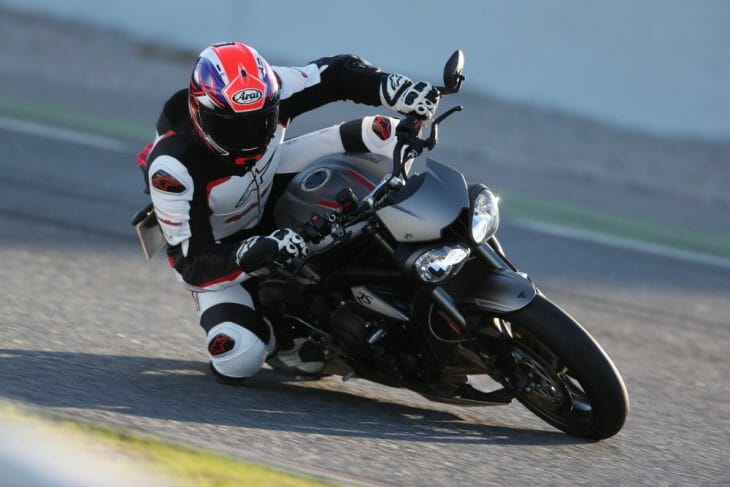 As a track day weapon, you’ll be able to humiliate plenty of bigger bikes on a Street Triple RS.
As a track day weapon, you’ll be able to humiliate plenty of bigger bikes on a Street Triple RS.
There are certain motorcycles out there that make you glad to be alive. Triumph’s Street Triple has always been one of these. A mix of heady performance and good looks lit up with a touch of youthful mischief, the Street Triple is one of—if not the—most important motorcycles in the Hinckley manufacturer’s line up.
The Street Triple been a roaring success since its 2007 debut. Triumph has sold a whopping 50,000 of these things across the world since then, but while the model has seen progressive updates in that time, they’ve stopped short of reinventing the Street Triple wheel, until now.
 All new styling, including the daytime running lights, gives the Street Triple RS a thoroughly modern look.
All new styling, including the daytime running lights, gives the Street Triple RS a thoroughly modern look.
New year, a new Triumph
For 2017, the Street Triple expands from one to three machines—the Street Triple S, R and this version, the rip roaring, laugh-your-ass-off RS. Already the lightest in the middleweight class and now with a claimed 4.4lb shaved off, all three machines get the new 765cc inline three-cylinder engine in various states of tune (the S gets 106hp, the R 118hp and the RS 121hp in U.S. guise), along with a steady upgrade of suspension and brakes and, for the first time on the Street Triple range, the electronics suite.
Starting with the DOHC, liquid-cooled, inline three-cylinder engine, Triumph has taken their 675 Daytona supersport motor and bored and stroked it to get 78 x 53.4mm measurements to move it to that 765cc capacity, thus keeping the Street range firmly in the middleweight category. It’s seen the Street Triple RS (replacing the Rx model), gain 16 percent in overall power and 13 percent in overall torque—it has more torque at 4000rpm than the Rx did at peak revs.
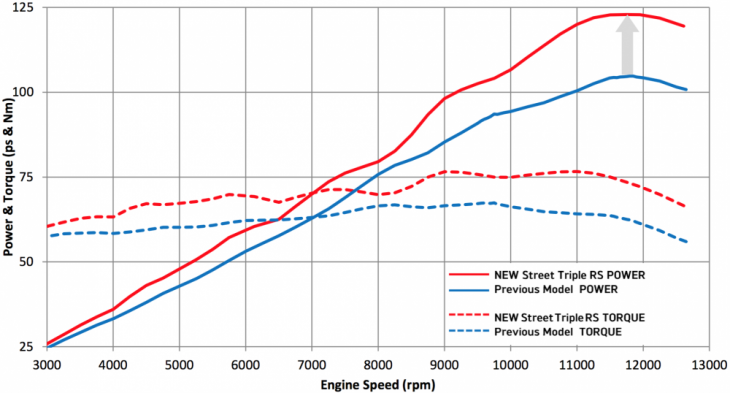 You can see here the massive gains of the new 765cc motor versus the old 675cc version.
You can see here the massive gains of the new 765cc motor versus the old 675cc version.
“With the RS, we focused heavily on tuning the engine,” says Triumph’s Head of Engineering, Stuart Wood. “We’ve taken it further. We’ve given it more power and more torque everywhere, but we’ve focused on the top end as well. In all we’ve changed 80 parts in this engine.”
The engine houses a new crank, con-rods, pistons, balancer shaft, nikasil aluminum bores (that replace the iron bore liners of the old 675cc engine), cylinder head and camshafts (the S and the RS run the same cams, the R get different ones), as well as a new intake and new three-into-one exhaust system that allows the triple to sing like never before. There’s also a new slip and assist clutch, a factory fitted quickshifter on this RS model and shorter first and second gears to take advantage of that extra torque off the line.
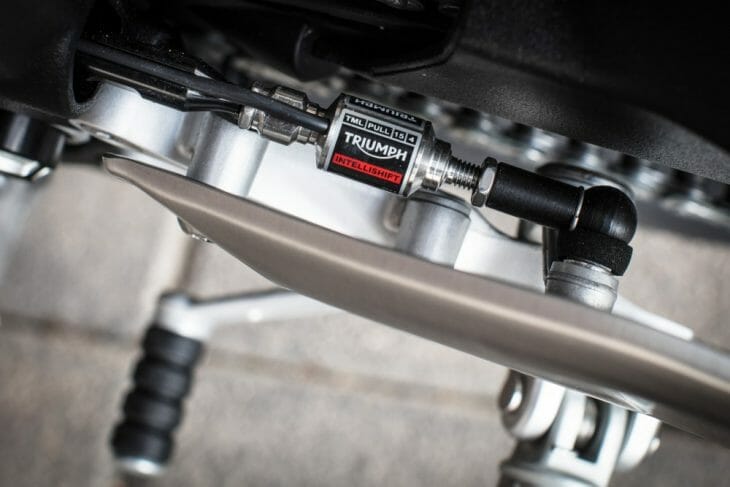 Like your gear changes without having to back off? Triumph’s got you covered with the RS’s quickshifter.
Like your gear changes without having to back off? Triumph’s got you covered with the RS’s quickshifter.
The RS is the most track focused of the three new Street Triples and comes with not only the most power and torque but an extra two riding modes over the S (Road, Rain) and three over the R (Road, Rain, Sport) in Road, Rain, Sport, Rider Programmable and Track. Each mode allows varying levels of throttle control outputs via the new Ride-By-Wire system, and work together with the chosen ABS and traction control settings. Incidentally, you get the full power of the motor in each riding mode when on wide open throttle, it’s just the ECU mitigates the initial throttle opening. Rider Programmable is exactly what it stands for and allows you to dial in as much or as little TC or ABS (and indeed switch off altogether) as you like via the absolutely brilliant new TFT dash and joystick set-up (more on this a little later). And, in a first for the category, you get self-canceling indicators on the R and RS models, and lap timer on the RS.
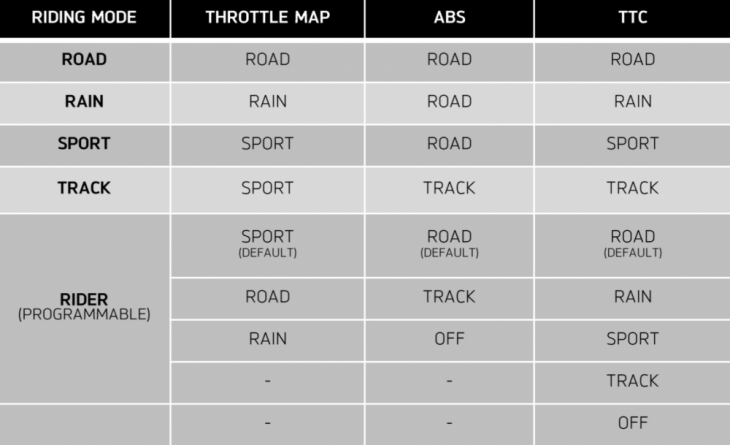 This graph gives you a quick overview of the RS’s mode set-up.
This graph gives you a quick overview of the RS’s mode set-up.
Top hardware for the Triumph Street Triple RS
As they say in the classics, power is nothing without control and the RS gets the full gamut of chart topping suspension and brakes in the fully-adjustable 41mm Showa Big Piston forks, Öhlins STX40 monoshock and the same Brembo M50 front brakes you’ll get on something like a Ducati Panigale. And there’s nice little touches in the brakes, with the Brembo master-cylinder allowing for ratio and span adjustments so you can dial in the exact amount of lever pull and feel you like.
The chassis itself has come in for a few mods: there a new gullwing swingarm that’s stiffer in longitudinal torsional stiffness but softer in lateral stiffness, with a new pivot position to Triumph claims provides a more natural resistance rear suspension compression under hard acceleration, and allows for tighter corner exists and maneuverability.
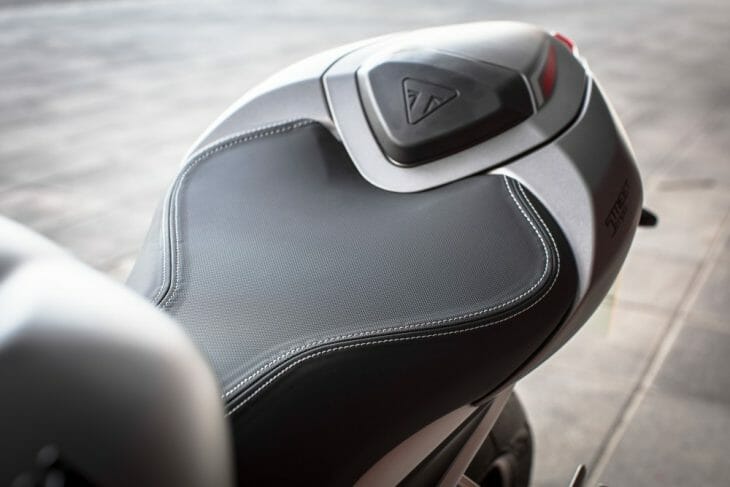 Nice bum. The seat unit and detail finishes are excellent on the Street Triple RS.
Nice bum. The seat unit and detail finishes are excellent on the Street Triple RS.
You also get stupendous grip via the Pirelli Supercorsa SP tires that come as standard fitment on the RS.
Aesthetically, the RS is a cut above the S and the R. The brand new bodywork gets an alluring silver paint (branded Matt Ice Silver) and Phantom Black color scheme, color-coded belly pan, single seat cowl cover and screen, new radiator cowls and integrated air intake, bar-end mirrors as well as a silver subframe (the S gets a black subframe and the R gets red).
So the Street Triple RS looks great on paper and in the metal. How does it go? The short and long answers are both the same: absolutely fantastic. There’s very, very little I don’t like about this bike.
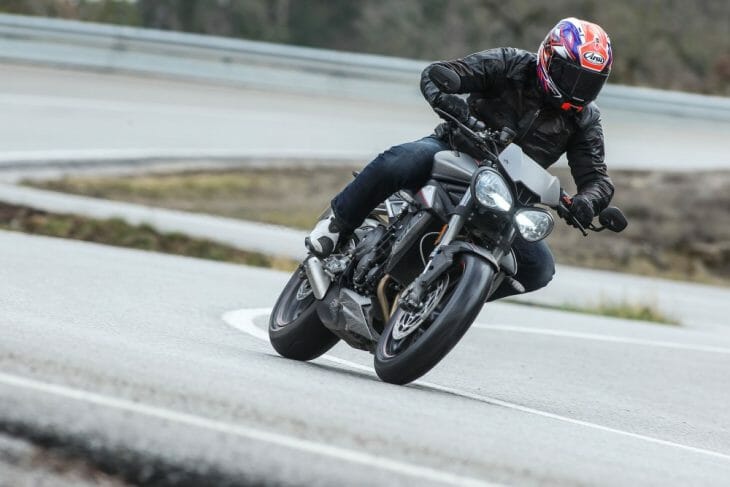 Crappy morning weather highlighted just how smooth the new engine is as well as the electronics.
Crappy morning weather highlighted just how smooth the new engine is as well as the electronics.
The reason for my enthusiasm is not down to any one part of the motorcycle. It’s the sum of the parts that make the RS ride so damn enthralling that at the end of a day’s blasting around the hills of Barcelona and God’s own racetrack of the Circuit de Catalunya—yes, that racetrack—I really didn’t want it to end (I could have ridden a Honda Cub around there and never wanted to leave).
The RS combines all the great things about riding and very few of the bad ones. At 6’1” tall I fit on the RS nicely, but if I have one complaint it’s that I’d have liked the bars maybe half an inch wider and higher for a touch more cockpit room. That said, overall comfort is not an issue—the pegs are nicely positioned and the seat ultra-comfortable—and the fitment of the trademark screen does more to alleviate the chest pounding you get from oncoming wind than its size would have you believe.
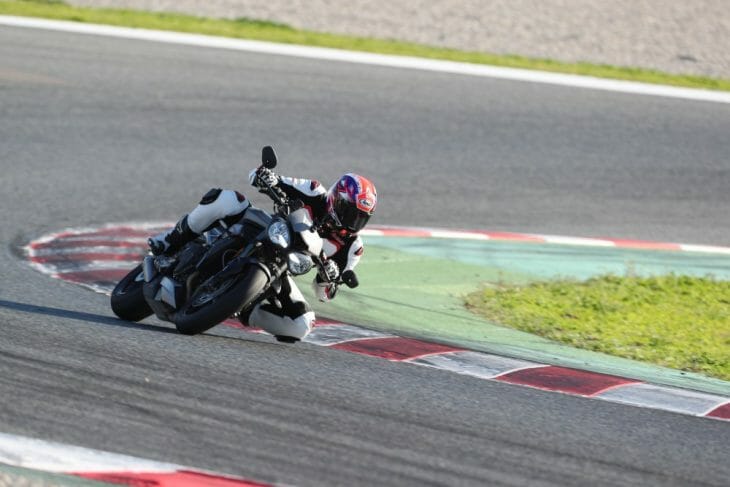 Getting stuck into it on track: The Street Triple loves this sort of thing.
Getting stuck into it on track: The Street Triple loves this sort of thing.
Punching on, three cylinder style
There’s many stars of the Street Triple RS show but it’s hard to go past the new motor. At a claimed 121hp (123hp in Euro guise) it’s not going to terrify you in terms of outright power, but it’s got more than enough to keep you entertained on the road and the track. The throttle response from closed is vastly improved (the throttle response becomes more direct the more you scroll through the available modes with Track giving close to a 1-1 throttle/rear wheel ratio) and the beefed up low-to mid-range torque means you can leave it a gear higher and surf the wave up to 8000rpm. That’s where the motor takes on a can of Red Bull and peps up substantially, thrusting you into the top-end accompanied by a soundtrack that’s hands down one of the best in motorcycling. Speaking of, the noise is a combination of chunky induction that sounds like it could suck in small children and an exhaust that’s refined and not as loud as you might expect. It sounds just plain great, and we’ll leave it at that.
 Hear me roar! The new, svelte exhaust system gives the triple a glorious, raspy engine note.
Hear me roar! The new, svelte exhaust system gives the triple a glorious, raspy engine note.
The gearbox is smooth, and together with the RS’s factory-fitted quickshifter means upshifts are dealt with quickly—although the shifter can be a little abrupt under light acceleration/low rpm in the first two gears. The quickshifter doesn’t work on downshifts, so it’s down to the cable actuated slip and assist clutch, a unit that works beautifully, especially on the racetrack.
And the racetrack is really where you’re going to explore the limits of the traction control system that’s been entirely designed in house at Triumph. This is a streetbike that’s unlikely to be raced, but that doesn’t mean the TC settings don’t let you have fun on the track. Across three sessions I ran with TC on Track mode, and finally ran with it and ABS switched off. It’s an excellent system, very unobtrusive when it cuts in, allowing you to maximize drive off the turns to get the full effect of the engine.
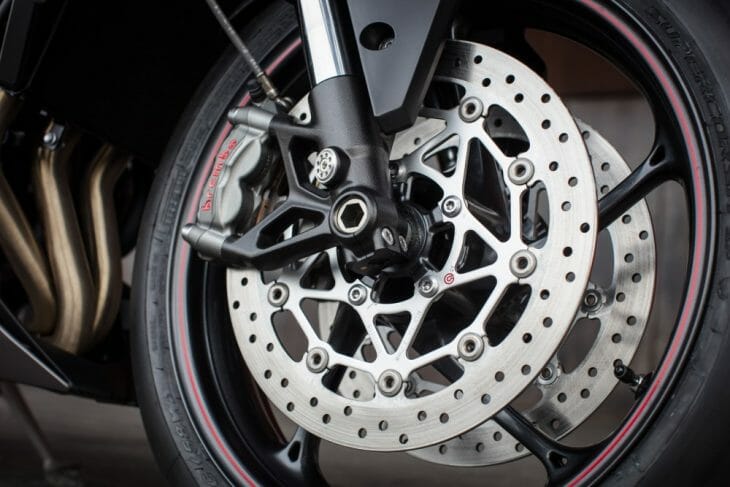 Brembo M50 stoppers are more than you need for a bike like the Street Triple RS. Still, it’s nice they’re there!
Brembo M50 stoppers are more than you need for a bike like the Street Triple RS. Still, it’s nice they’re there!
With the settings set to “off” for the last session, it highlighted two things: the first being how smooth and controllable the engine is when unshackled by the admittedly great TC system; the second just how much grip you get with Supercorsa SP rubber when mated to only 120-odd hp. Remember, these tires come standard fitment on something like a 190hp Panigale, so a Street Triple RS, for all its lovely three-cylinder torque, isn’t going to stress the Italian rubber too much.
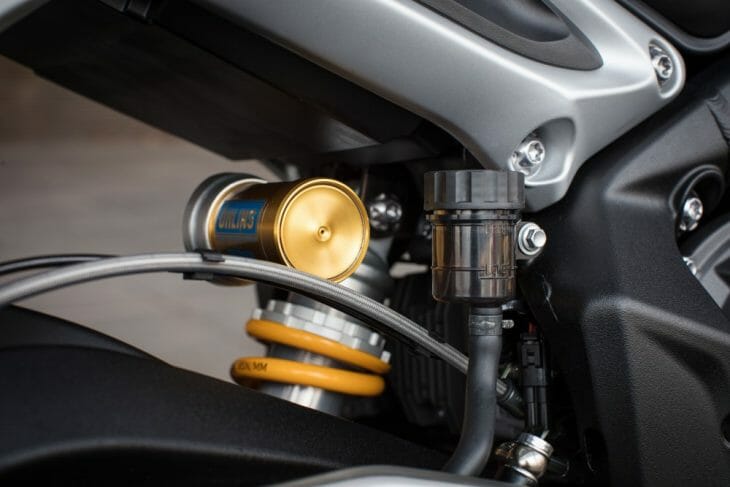 Öhlins STX40 shock is a great little unit and provides plenty of comfort and track support
Öhlins STX40 shock is a great little unit and provides plenty of comfort and track support
The suspension itself is class. The fully adjustable Öhlins STX40 shock combines beautifully with the equally adjustable Showa Big Piston fork to give a ride that, in standard settings on the road, is plush at speed but with plenty of controllability and poise under braking using those excellent M50 stoppers and 310mm discs. And when switched to the track, you get lots of feel and feedback at high lean angles to know exactly where you are and what the chassis is doing. The quality suspension, combined with the Pirellis, give the Street Triple excellent mechanical grip and make for a bike that’s plain easy to ride, be it negotiating city traffic or jetting out of “Rossi’s Corner” onto Catalunya’s front straight.
Finally, someone got the dash right!
Another great aspect of the RS is something that is becoming more important to me as bikes become more electronically controlled, and that’s the dash. Most bikes these days come with either traction control, ABS, variable rider modes, whatever else, but it’s amazing how confusing some dashes are to use while some manufacturers get it spot on.
 These are the three dash themes you get standard on the Street Triple R and RS.
These are the three dash themes you get standard on the Street Triple R and RS.
The RS’s 5-inch TFT display dash is firmly in the latter, and allows you to change pretty much every aspect of the Triumph’s electronic aids quickly and easily via the four-way joy-stick on the left switchblock. You can even change the angle of the dash via the little silver lever on the bottom left of the screen.
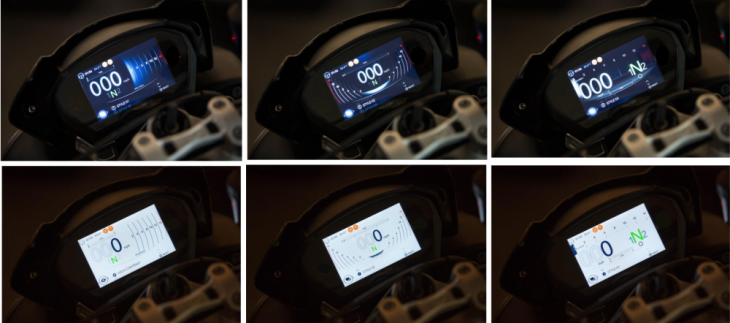 And these are the dash themes you get only with the Street Triple RS. Sorry, S and R riders…
And these are the dash themes you get only with the Street Triple RS. Sorry, S and R riders…
The base model Street Triple S gets three different themes you can chose from, but the R and the RS get an extra three, allowing you to configure the revs, speed, modes and other assorted information how you like. All the dashes (on the S through to the RS) get an Auto setting that uses an ambient light sensor and changes the background from black to white depending on the available light, or you can set it to what you want and it won’t change.
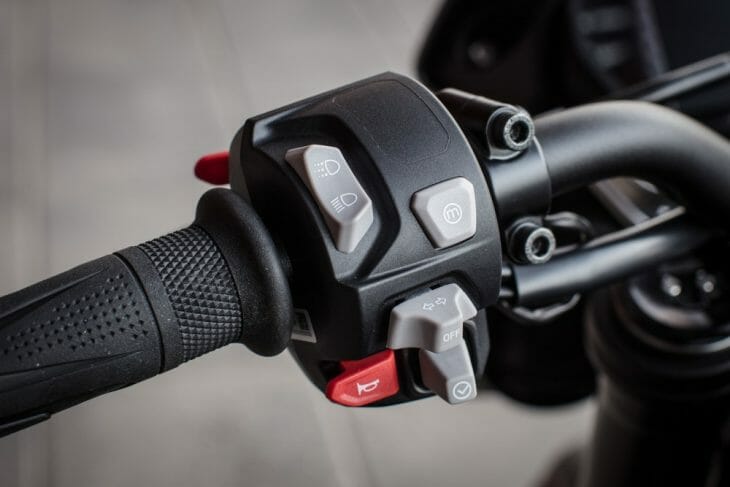 It’s all changed by the mode switch (M) and the little joystick on the bottom (marked with the tick).
It’s all changed by the mode switch (M) and the little joystick on the bottom (marked with the tick).
Triumph has developed a range of over 60 accessory parts in its aftermarket catalogue for the Street Triple range, so you’ll be able to customize your Triple to your tastes easily. We had our bike fitted with the heated grip option—a welcome addition on the freezing cold Spanish morning we set off in!
The Street Triple RS is priced pretty steeply at $12,500 MSRP, a fair bit more than something like the comparable Yamaha FZ-09 at $8,999 (and not far off that company’s FZ-10 at $12,999), but you are getting a seriously quality product in terms of running specification with your purchase. Besides, if that’s too much for you, you can get a lower spec S model at $9,900 or the R at $11,200 (which also comes in a low suspension and seat height model).
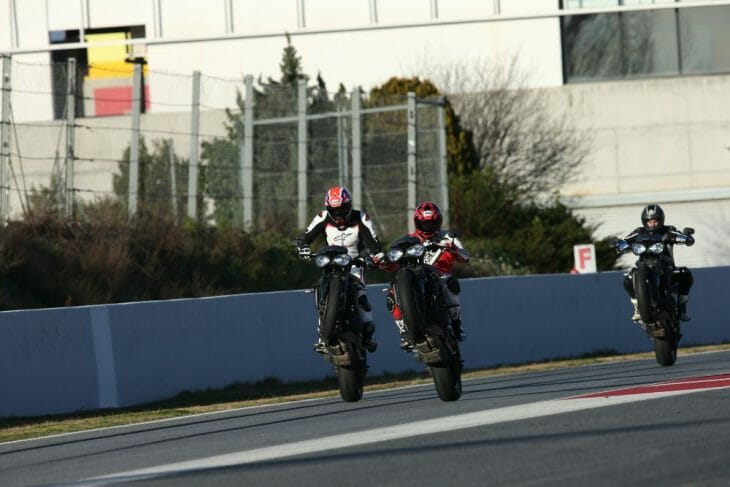 Wheelies on Street Triples are fun, but wheelies on Street Triples with buddies is better!
Wheelies on Street Triples are fun, but wheelies on Street Triples with buddies is better!
However, despite the price, I must say this bike is seriously good fun. In terms of the ride experience, Triumph has hit this one out of the park. The combination of engine, chassis, suspension, brakes, ergonomics, electronics and quality finish is superb on the Street Triple RS.
Like I said earlier, there’s very, very little I don’t like about this bike.
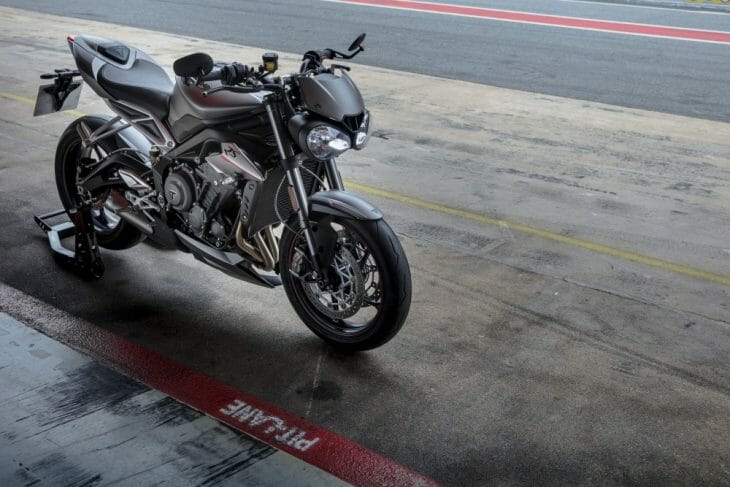 If you don’t have fun on this bike, you might want to check your pulse.
If you don’t have fun on this bike, you might want to check your pulse.
Specifications
2017 Triumph Street Triple RS
Engine: Liquid cooled, four-stroke, 12valve, DOHC in line three
Displacement: 765cc
Bore x stroke: 78 x 53.4 mm
Horsepower: 121 hp @ 11,750 rpm (claimed)
Torque: 56.8 lb-ft @ 10,800 rpm (claimed)
Compression ratio: 12.65:1
Fuel system: Multipoint sequential electronic fuel injection with SAI. Electronic throttle control. 5 throttle modes.
Exhaust: 3 into 1
Transmission: Six-speed gearbox. Quickshifter-equipped.
Chassis: Aluminum beam twin spar
Front suspension Showa 41 mm upside down big piston forks (BPF), 115 mm front wheel travel. Adjustable compression damping, rebound damping and preload
Rear suspension: Öhlins STX40 piggyback reservoir monoshock, 131 mm rear wheel travel. Adjustable spring preload (lock-rings), compression damping and rebound damping.
Front brake: Twin 310 mm floating discs. Brembo M50 4-piston radial monobloc calipers
Rear brake: Single 220 mm fixed disc, Brembo single piston sliding caliper
Front tire: 120/70 ZR17 Pirelli Diablo Supercorsa SP
Rear tire: 180/55 ZR17 Pirelli Diablo Supercorsa SP
Rake: 23.9°
Trail: 3.9 in
Wheelbase: 55.5 in
Overall length: 81.3 in
Seat height: 32.5 in
Fuel capacity: 4.6 gal
Weight: 3.9 in. (dry, measured).
Color: Matt Ice Silver and Phantom Black
MSRP: $12,500 MSRP
Click here for all the latest motorcycle test and reviews.
Click here fro all the latest Triumph motorcycle test and reviews.